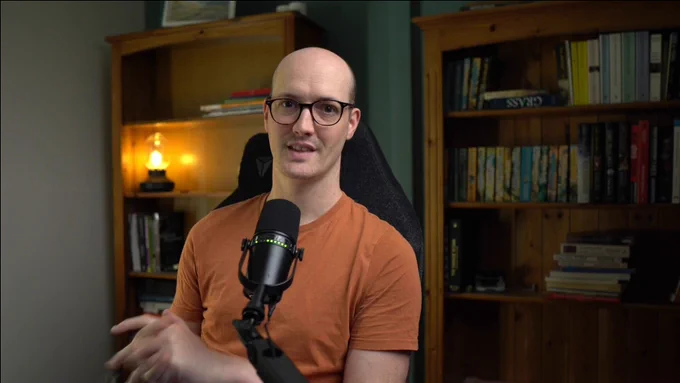Former FPS Analyst | Now writing brutal cyberpunk meets steampunk via vertical cities - class genocide | THE CONSCIOUSNESS WARS | Book 1: 2025
Here
Joined October 2022
- Tweets 4,544
- Following 1,475
- Followers 157
- Likes 530
The Consciousness Wars: I've received some very useful and entertaining beta reader feedback from Book 1 of my collection that I'm writing. Science Fiction and Fantasy aka SFF that I've turned into Thematic Realism SFF really paid off!
KHruska retweeted
Ever wondered why the longer your chat grows, the stupider the AI becomes?
It might be because you don't understand how context windows work.
Let me enlighten you:
KHruska retweeted
Instead of “I’m bad at this”.
Say “This is new for me”.
This gives your brain the space to learn instead of shut down.
This is neuroplasticity in real time.
KHruska retweeted
Scientists from Spain and China have made a major breakthrough in Alzheimer’s research. They created special nanoparticles that can clear away toxic brain plaque — one of the main causes of Alzheimer’s — and even reverse memory loss in mice. The study, published in Signal Transduction and Targeted Therapy, showed that just three injections of these nanoparticles removed up to 60% of the harmful amyloid beta proteins from the brain within one hour.
The most amazing part is what happened afterward. Mice that had severe memory and thinking problems started behaving like normal, healthy mice again within six months. This dramatic recovery happened because the treatment didn’t just clean up the brain — it also repaired the brain’s blood-brain barrier (BBB). This barrier normally protects the brain and helps remove waste, but in Alzheimer’s, it becomes damaged and allows harmful substances to build up.
These nanoparticles work like a “supramolecular drug,” which means they do more than just carry medicine — they actively help restore the brain’s natural cleaning system. They reactivate an important protein called LRP1, which helps clear waste from the brain. By fixing this system, the treatment improved blood flow, reduced inflammation, and allowed the brain to start healing itself.
Although this research is still in the animal-testing stage, it opens an exciting new direction for Alzheimer’s treatment. Instead of only trying to destroy toxic proteins, future therapies might focus on reviving the body’s natural defenses. If this approach works in humans, it could completely change how we fight Alzheimer’s and other brain-degenerative diseases.
And this is why I respect people like Elon. I have to ignore a lot of the political bravado these days - but if you dig deeper into them as people, you can take in so much...it's unreal. Wild, really.
Elon Musk describes first principles thinking as a superpower, and it truly is. Because most people never learn how to think — they just learn how to remember. They copy, they imitate, they accept. But when you break problems into their most fundamental truths, when you question everything — you step outside the illusion of precedent. That’s how Tesla, SpaceX, and Neuralink happened. Physics doesn’t care about legacy systems. It only cares about what’s possible.
I love these kinds of posts. They feed my worldbuilding expertise for #SFF writing. There's so much a writer can do with this.
KHruska retweeted
>Augmented reality + generative AGI means people can suddenly do expert-level work they never trained
it's already here
Two underdiscussed possibilities:
Augmented reality + generative AGI means people can suddenly do expert-level work they never trained for. Real-time overlays guide you through any task - repairs, construction, technical assembly, complex procedures. Visual guides showing exactly where your hands go, which tool, what sequence. Voice coaching for every step. Everything you already do becomes dramatically more efficient, and things you'd never attempt without years of training become accessible. Capability explosion across every domain.
Second: AI integrated into all information systems - browsers, OS, overlaid through AR on the physical world. Real-time fact-checking on everything you see. Claims verified automatically, context provided, manipulation flagged. Truth becomes the default, assuming our AI systems can actually access it.
Interesting - psychology mixed with #SFF . What's there not to like about this!!!
We are excited to announce the upcoming publication of THE JOPLIN HORROR by @jasonkaleko 🥳 This is a cinematic horror about a crew of graverobbers who become chased by a malevolent entity through a labyrinthine nightmare, exploring trauma, grief, and the fragility of memory.
KHruska retweeted
Marco Arnautovic was in tears at his first Red Star Belgrade press conference.
He promised Sinisa Mihailovic, his former coach at Bologna who died of leukaemia, that one day he would play for them.
Respect. ❤️
KHruska retweeted
NASA DETECTS EARTH’S HEARTBEAT - PLANTS LITERALLY GLOW FROM SPACE
Plants glow a faint red light while they photosynthesize, and satellites can see it from space.
NASA and NOAA use that glow to track how much carbon dioxide plants are absorbing; It’s like checking the planet’s vital signs with laser vision.
Paired with tools like the Greenness Index, it's done to help scientists map the Earth’s carbon cycle and see how healthy (or not) our biosphere really is.
The result? A glowing red Earth, pulsing with plant activity.
Source: National Science and Media Museum
🇺🇸 PARKER SOLAR PROBE TANKS A SOLAR EXPLOSION LIKE A CHAMP
NASA’s Parker Solar Probe just did the intergalactic version of walking through a volcano... and survived.
It flew straight through a coronal mass ejection, a.k.a. the sun throwing a giant flaming tantrum of plasma.
Scientists say it's like scooping up a chunk of the sun and hurling it across space. Casual.
The probe’s built like a tank with a heat shield, so it didn’t melt into space goo.
This helps scientists figure out how to stop solar rage from wrecking our Wi-Fi, satellites, or entire power grids.
Next up, the probe will zoom to 430,000 mph and get within 3.9 million miles of the sun.
Basically, a cosmic close shave.
Source: Mashable










































